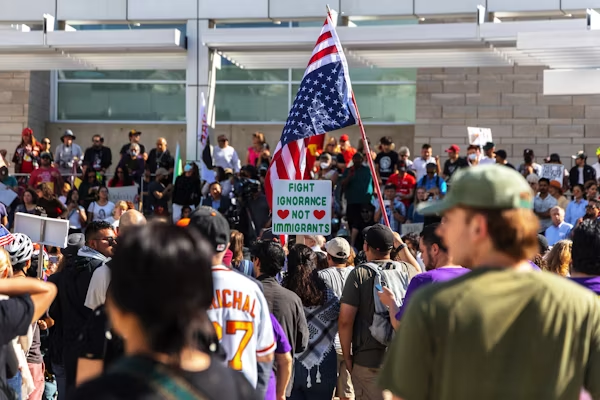Table of Contents
The Crisis and the Call to Action
America at a Breaking Point
The United States entered 2025 under mounting pressure — politically fractured, economically uneven, and socially divided. But nothing stirred emotions like the immigration crisis. Millions of migrants from Latin America and beyond sought entry into the U.S., overwhelming border facilities and testing the limits of the federal system.
The Biden-Harris administration’s earlier reforms had failed to resolve deep-seated problems. When Trump returned to power, he promised “a total restoration of border control.” Yet, his approach quickly reignited old tensions, especially in states like California that embraced sanctuary policies.
As immigrant communities organized marches to protest mass deportations and border raids, the demonstrations spread like wildfire — from San Diego to Los Angeles, the nation’s second-largest city and a cultural symbol of diversity. Within weeks, peaceful rallies morphed into nightly clashes. Property was damaged, arrests mounted, and the situation spiraled.
That’s when Trump acted.
The Immigration Crisis That Sparked It All
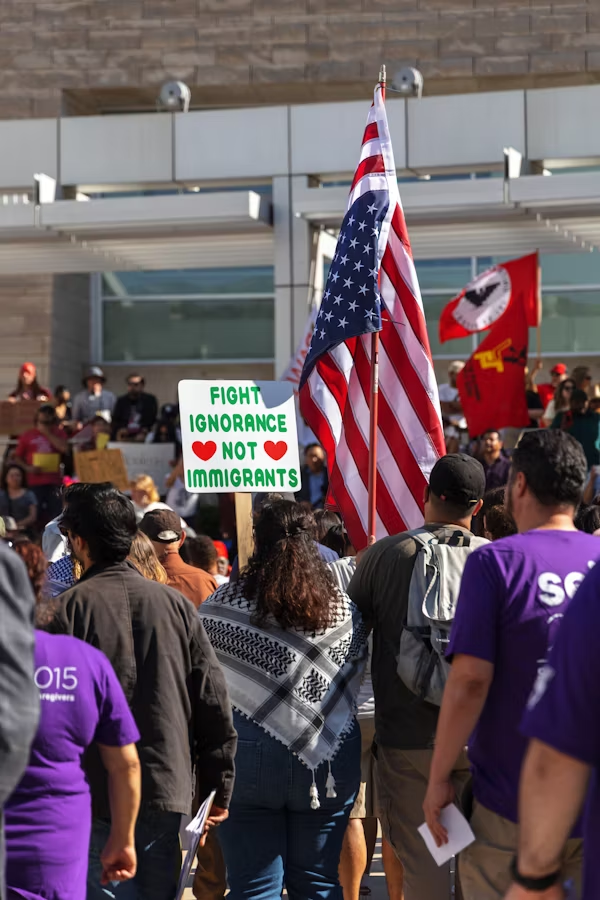
At the heart of the conflict lay Trump’s new immigration doctrine — “Zero Tolerance Plus.” It not only reinstated family separations and expedited deportations but also restricted asylum applications to a narrow set of “security-priority” cases.
Critics called it a humanitarian disaster; Trump called it a “return to law.”
Border crossings surged despite the crackdown, pushing the administration to announce new detention centers and military assistance at ports of entry. Reports emerged of overwhelmed immigration courts and overcrowded facilities.
Public outrage grew, fueled by viral footage of families being detained and buses transporting migrants under heavy guard. Advocacy groups accused the government of criminalizing asylum seekers, while Trump supporters argued that “a country without borders isn’t a country at all.”
The issue, already combustible, became the spark that lit the protests.
The Protests Erupt
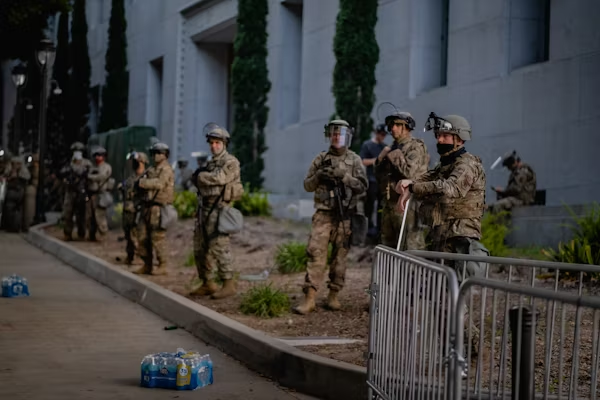
Los Angeles became ground zero for dissent.
On a brisk February morning, tens of thousands of demonstrators filled Pershing Square, waving banners that read “No Human Is Illegal” and “Stop the Raids.” Faith leaders, immigrant families, and civil rights activists spoke out against Trump’s policies.
But the tone shifted dramatically as night fell. Small groups of agitators clashed with police, hurling bottles and setting fires near federal buildings. Viral videos of tear gas clouds and riot shields ignited outrage online.
Within 72 hours, what began as a peaceful outcry turned into widespread unrest. Police officers were injured, federal property vandalized, and curfews declared. The city’s leadership appealed for calm, but the protests kept growing — and Trump’s patience was wearing thin.
Trump’s Decision to Deploy Marines
In the Situation Room, Trump and his top advisors convened for an emergency briefing. Intelligence reports suggested organized attempts to storm federal immigration offices and disrupt deportation transports. The Department of Homeland Security requested backup — and Trump didn’t hesitate.
At 2:00 a.m. Washington time, he signed an executive order authorizing the deployment of U.S. Marines to Los Angeles under the pretext of protecting federal installations.
The order stunned even members of his own administration. The Pentagon, initially cautious, warned that military involvement in civilian affairs could “blur lines of jurisdiction.”
But Trump pushed forward, declaring that “domestic terrorism masquerading as activism” had to be stopped.
Trump’s Statement to the Nation
By morning, Trump addressed the country from the Oval Office. His tone was firm, almost defiant.
“I will not allow our great cities to fall to chaos. The Marines are there to protect our people, not to intimidate them. We will defend our borders, our buildings, and our way of life.”
He framed the deployment as a moral necessity, comparing it to past interventions during crises like the 1992 L.A. riots.
To his supporters, the speech was vintage Trump — tough, unapologetic, and direct.
To his critics, it was chilling — a sign that the President was normalizing military presence in civilian life.
Scenes from Los Angeles: Streets Under Siege
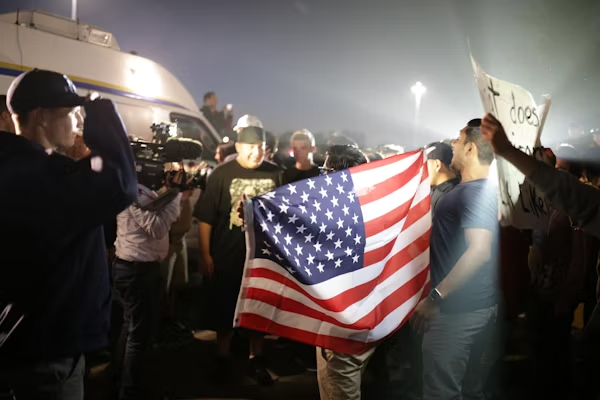
Within 24 hours, armored vehicles rolled through downtown Los Angeles. Marines, clad in tactical gear, were positioned near federal courthouses and immigration centers. Drones patrolled the sky, and the once-bustling city streets fell eerily quiet under a dusk-to-dawn curfew.
Residents described scenes of fear and confusion. “It felt like a war zone,” said Angela Rivera, a community organizer. “We were protesting deportations — not starting one.”
Meanwhile, Trump supporters organized counter-rallies, waving American flags and chanting, “USA! USA!”
The city became a stage for America’s ideological divide — one side demanding justice, the other demanding order.
The Role of the Marines — Mission and Mandate
The Marines’ orders were narrowly defined — at least on paper. Their mission: safeguard federal property, assist local police if requested, and ensure secure transportation routes for detained migrants.
But critics argued that their presence had a chilling effect on civil rights. Videos emerged showing armed troops standing beside police lines, and rumors spread of Marines detaining protesters — something the administration denied.
Pentagon officials privately expressed concern that the line between “support” and “enforcement” was blurring fast. Legal experts pointed out that the Posse Comitatus Act prohibits using military personnel to enforce domestic laws without explicit Congressional approval.
Still, the White House defended the deployment, insisting it was “limited, legal, and necessary.”
California’s Response
Governor Gavin Newsom’s reaction was swift and fiery.
“This is not martial law,” he said at a press conference. “This is a power grab.”
He ordered state agencies to monitor the Marines’ activities and vowed to challenge the deployment in court.
California’s Attorney General filed a motion citing constitutional violations, arguing that the federal government had bypassed the state’s authority.
In Sacramento, lawmakers held emergency hearings, condemning the move as “an authoritarian overreach.” Meanwhile, local mayors pleaded for de-escalation, fearing that confrontation could make things worse.
Political Fallout
The political world erupted.
Republicans in Congress largely backed Trump, echoing his message of “law and order.” Senator J.D. Vance called the decision “courageous leadership in the face of anarchy.”
Democrats, however, were united in outrage. Senator Alex Padilla of California declared,
“Trump has sent troops against American citizens exercising their constitutional rights. That’s not leadership — that’s tyranny.”
Cable news and social media turned the event into a 24/7 debate. Was Trump protecting America or pushing it toward a constitutional crisis?
One thing was clear: this was no longer just about immigration. It was about the future of democracy itself.
The National Reaction, Legal Battles, and Global Impact
National Reactions and Public Sentiment
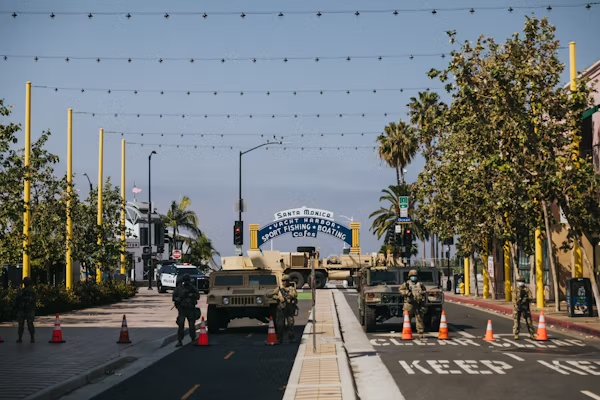
When images of armed Marines patrolling Los Angeles hit television screens and social media, the nation froze. Americans were torn between two competing visions: one of safety and control, another of fear and repression.
A Reuters/Ipsos poll conducted days after the deployment revealed just how divided the country was:
- 61% of Republicans approved of Trump’s decision.
- 77% of Democrats condemned it.
- 54% of Independents said it made them “uncomfortable” with the direction of the government.
On talk shows, pundits debated whether this was a necessary act of protection or a step toward authoritarianism. Meanwhile, everyday citizens voiced mixed emotions.
“I feel safer knowing the Marines are there,” said Daniel Carter, a downtown shop owner. “The looting was getting out of hand.”
But Lina Alvarez, a student protester, countered: “We’re being treated like criminals for demanding justice. Is this still America?”
Across the nation, fear, anger, and pride collided in a storm of emotion that would shape the next decade of politics.
Trump Doubles Down
Trump, characteristically defiant, refused to back down.
At a rally in Phoenix just days later, he thundered to supporters:
“We brought order back to Los Angeles. The fake news won’t tell you this, but the people there are grateful. We’re not going to let anarchists destroy our country.”
He accused the media of exaggerating civilian suffering and claimed that Democrats were “rooting for chaos.” His social media posts echoed the same themes — “law, borders, strength” — a triad that became a rallying cry for his base.
Behind the scenes, White House insiders leaked reports that Trump had privately told advisors, “If I hadn’t acted, L.A. would’ve burned like 1992.”
For his supporters, this reinforced the image of Trump as the strongman America needed. For his critics, it was confirmation of their worst fears.
The Legal Firestorm
The deployment quickly became a constitutional battle.
Civil rights groups, state attorneys, and lawmakers filed multiple lawsuits challenging the President’s authority to use active-duty Marines on U.S. soil. The cases centered on the Posse Comitatus Act (1878) — a law designed to prevent the federal military from enforcing domestic laws.
Trump’s legal team argued that the Marines weren’t enforcing laws but protecting federal facilities and personnel — a “gray area” that technically complied with the statute.
Federal courts were divided.
A lower court in California issued an injunction limiting Marine activity outside federal zones, but the Justice Department appealed.
The Supreme Court declined to intervene immediately, citing the issue as “politically sensitive.”
Legal scholars warned that this set a dangerous precedent. “If the definition of ‘protection’ can be stretched this far,” said Professor Alicia Grant of Harvard Law, “then the military can be deployed anywhere for anything.”
Military Response and Internal Discontent
Inside the Pentagon, not everyone was comfortable with Trump’s decision.
Reports surfaced that senior Marine commanders had voiced unease about being used in a domestic policing role.
Anonymous sources described tense exchanges between Defense Secretary Mark Esper and Trump’s inner circle, with Esper reportedly cautioning that “the optics of Marines on Main Street” could erode public trust.
Nevertheless, orders were followed. The Marines maintained discipline and avoided direct engagement with civilians, though their very presence cast a long shadow.
Leaked memos later revealed that several high-ranking officers requested early retirement in protest — echoing past episodes where military ethics clashed with executive politics.
Civil Rights Groups Step In
The ACLU filed a major lawsuit on behalf of protesters allegedly detained or intimidated during demonstrations. Amnesty International launched an investigation into claims of excessive force by federal agents accompanying the Marines.
Human Rights Watch issued a statement condemning “the militarization of civilian life,” warning that the U.S. was “setting an example that authoritarian regimes around the world will exploit.”
Street demonstrations reignited — this time against the troop presence itself. Protesters held signs reading “No Tanks in Our Towns” and “Democracy Doesn’t Wear Dog Tags.”
The movement gained traction online, uniting liberal activists, libertarians, and even some conservatives alarmed by government overreach.
The Role of the Media
Media coverage of the crisis was both relentless and polarized.
Fox News showcased “heroic Marines defending peace,” while MSNBC aired raw footage of tear gas and civilians pinned to the ground. CNN, caught in the middle, tried to maintain balance but was attacked by both sides.
Social media became a digital battlefield.
Hashtags like #MarinesInLA, #StandWithLA, and #Tyranny2025 trended for weeks. Deepfake videos and misinformation campaigns from foreign accounts flooded platforms, further blurring reality.
Citizen journalists, armed with smartphones, filled the gaps. Independent footage often contradicted official reports, fueling skepticism toward government statements.
In an age where information spreads faster than truth, perception became the real weapon.
International Reactions
America’s allies watched with growing concern.
Canadian Prime Minister Justin Trudeau called the situation “deeply troubling,” while the European Union urged the U.S. to respect civil liberties.
In contrast, Russia and China mocked the U.S. response, calling it “hypocrisy exposed.”
The United Nations Human Rights Council issued a rare statement expressing “grave concern” over military involvement in domestic affairs and called for restraint.
U.S. diplomats scrambled to contain the fallout, arguing that the crisis was “under control” and that “democratic institutions remain intact.”
But globally, America’s image as the “beacon of democracy” took a visible hit. For many foreign observers, Los Angeles became a symbol of a superpower struggling with its own ideals.
Congress Takes Action
On Capitol Hill, lawmakers clashed bitterly.
Democrats demanded a full investigation into Trump’s use of military force. Hearings were held in the House Armed Services Committee, where legal experts testified about executive overreach.
Republicans countered with bills seeking to expand presidential emergency powers, arguing that “the Commander-in-Chief must have the tools to defend the homeland.”
Despite fiery speeches and viral moments, Congress remained deadlocked.
Partisan warfare overshadowed governance, and no clear legislation emerged to prevent similar deployments in the future.
For many Americans, it was another sign that Washington was too divided to act — even in a constitutional crisis.
The Economic Fallout
Beyond politics and ideology, the crisis left a real-world toll.
Businesses in downtown Los Angeles suffered catastrophic losses. Tourism plummeted, conventions were canceled, and Hollywood productions paused amid curfews and security restrictions.
Economists estimated that the protests and deployment cost California’s economy over $5.6 billion in just six weeks.
Meanwhile, immigrant workers — the backbone of industries like construction and hospitality — faced layoffs and deportation fears.
The human cost was enormous: families separated, communities fractured, and neighborhoods scarred both physically and emotionally.
America Redefined — Legacy, Lessons, and the Road Ahead
The Human Toll
Behind the headlines and political theater, ordinary people bore the deepest scars.
Immigrant families who fled violence and poverty found themselves at the epicenter of another kind of conflict — one between their dreams and the nation’s politics.
Families were separated during curfews and raids. Activists who once led peaceful marches now faced trauma, job losses, and even deportation threats.
A 9-year-old girl, Maria Torres, whose parents were detained during a protest, told local media:
I’m afraid I won’t get to see my mother anymore,” the young girl said quietly. “I just want her back. I just want her to come home.”
Her story became a haunting symbol of what many described as “America losing its compassion.”
Mental health professionals reported spikes in anxiety and depression among immigrant and Latino communities. “The sense of fear is constant,” said Dr. Elisa Ramirez, a Los Angeles psychologist. “People no longer trust their government — or even the streets they live on.”
America’s Image at Home and Abroad
Globally, the U.S. found its moral authority weakened.
Allies who once looked to Washington for guidance now questioned its stability. European diplomats privately expressed dismay at “America’s internal contradictions.”
In Latin America, where many migrants originated, the optics were devastating. Videos of armed Marines detaining unarmed protesters aired alongside footage of border patrols, fueling anti-American sentiment.
China and Russia seized the opportunity to criticize the U.S., framing the crisis as “proof that Western democracy is collapsing.”
The Kremlin’s foreign ministry even released a sarcastic statement:
“Perhaps the U.S. should focus on its own human rights before lecturing others.”
For decades, America prided itself as the global defender of democracy. But after Los Angeles, many began to wonder: had the defender become the offender?
The Battle for Narrative Control
As the weeks went on, the fight wasn’t just in the streets — it was in the story.
Trump’s team flooded social media with patriotic imagery of Marines saluting flags, defending buildings, and helping citizens.
The White House framed the deployment as “Operation Civic Shield,” branding it as a success story of “American strength.”
Meanwhile, opposition movements used alternative media, podcasts, and documentaries to counter the official story.
Filmmaker Ava DuVernay’s short film “Occupied Streets” went viral, depicting the fear and confusion of that night in Los Angeles.
On X (formerly Twitter), hashtags like #TruthOverPower and #RememberLA became digital battle cries.
In the end, the truth became subjective — split between two competing realities, each one shaped by belief, not evidence.
The Courts Step In
By mid-2026, the Supreme Court finally ruled on the constitutional challenges brought against Trump’s actions.
In a narrow 5–4 decision, the Court upheld the President’s authority to deploy troops in “emergency situations threatening federal operations.”
Chief Justice Roberts, in his majority opinion, wrote:
“While caution is advised, the Constitution vests broad discretion in the Executive to defend national interests.”
Justice Sotomayor’s dissent, however, became one of the most quoted opinions in modern history:
“Liberty dies not in the absence of law, but in the silence of those who fear to challenge its abuse.”
The decision effectively expanded executive power, setting a precedent that future presidents could invoke — one that critics warned could erode the very safeguards of democracy.
Inside the White House — Strategy or Survival?
Behind closed doors, Trump’s advisors debated how to navigate the storm.
According to leaked memos later published by The Washington Post, the move was not just about order — it was political survival.
Polling data had shown Trump’s approval slipping among moderates. The deployment, strategists argued, would “rally the base and reframe the narrative around leadership and strength.”
Trump himself, ever the showman, viewed it as an opportunity to reaffirm his image as “the President who acts, not apologizes.”
But inside the administration, tensions simmered. Several aides reportedly resigned, uncomfortable with the optics of “military muscle for political message.”
The Aftermath in Los Angeles
Months after the Marines withdrew, Los Angeles began to heal — slowly.
Graffiti memorials honoring protesters lined downtown walls. Churches and community centers held peace vigils. Nonprofits offered trauma counseling and legal aid.
Mayor Karen Bass established a commission called “Rebuild L.A. 2025” to document abuses and recommend reforms.
In her address to the city, she said:
“We were tested, we were shaken, but we will not forget. Our strength is not in our fear, but in our unity.”
Gradually, life returned to the city. Yet, the scars remained — not just on buildings, but in hearts.
The Broader Political Fallout
The deployment reshaped America’s political landscape.
In the 2026 midterm elections, voter turnout hit record levels. Democrats gained seats in Congress, capitalizing on public anger, but Republicans held firm in conservative strongholds.
Trump’s approval rating dipped nationally but soared among his core base, solidifying his influence over the Republican Party.
A new generation of politicians emerged, defining themselves through the lens of this crisis — either as defenders of liberty or enforcers of order.
The phrase “Law and Order vs Liberty” became the defining political slogan of the era — a fault line that continues to divide the nation.
Lessons Learned — Democracy Tested
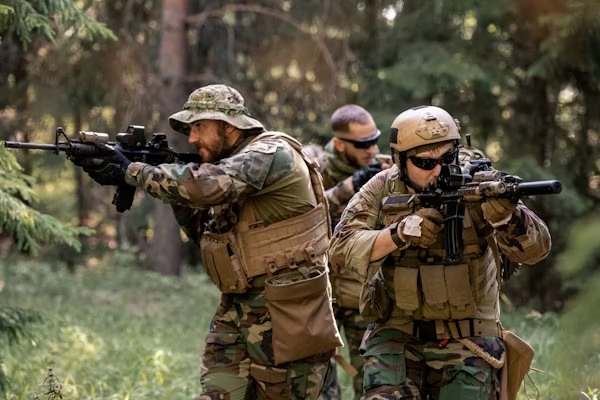
The Los Angeles deployment forced America to confront uncomfortable truths about itself.
It revealed how fragile democratic institutions could become when stretched by fear and polarization.
It showed that “law and order,” when unchecked, could easily slip into repression — and that “freedom,” without responsibility, could descend into chaos.
But it also highlighted the resilience of the people.
Journalists who risked arrest, lawyers who fought in courtrooms, protesters who stood peacefully despite intimidation — these became the quiet heroes of the story.
Looking Ahead — America’s Future at a Crossroads
As historians look back, 2025 stands as a defining chapter in the American experiment.
Trump’s defenders will say he acted decisively in defense of the nation. His critics will say he crossed a sacred line that should never have been touched.
The truth, perhaps, lies somewhere in between — a reminder that power, once expanded, is rarely surrendered.
The deployment of Marines to Los Angeles was not just an event. It was a mirror — reflecting both the best and worst of what America can become.
The question that remains: will the country learn from it, or repeat it?
Conclusion
The story of Trump’s defense of Marine deployment is not simply a political episode — it’s a test of America’s soul.
Security versus liberty. Order versus justice. Patriotism versus dissent.
Each citizen must now decide where they stand — and what kind of America they wish to live in.
FAQs
1. What exactly triggered the deployment of Marines in Los Angeles?
The decision came after violent escalations during immigration protests and alleged threats to federal buildings.
2. Was the move legal under U.S. law?
Technically yes, but it stretched the limits of the Posse Comitatus Act, sparking major constitutional debate.
3. How long did the Marines remain in Los Angeles?
The deployment lasted roughly six weeks before a gradual withdrawal amid political and public pressure.
4. Did the protests achieve any lasting policy change?
While immediate immigration laws remained, the backlash fueled future reform movements and political shifts.
5. How will history likely view this event?
As a turning point — a cautionary tale about power, protest, and the fragile balance between order and freedom.
